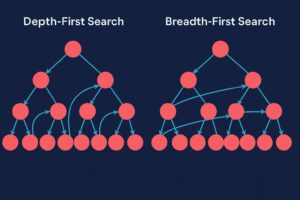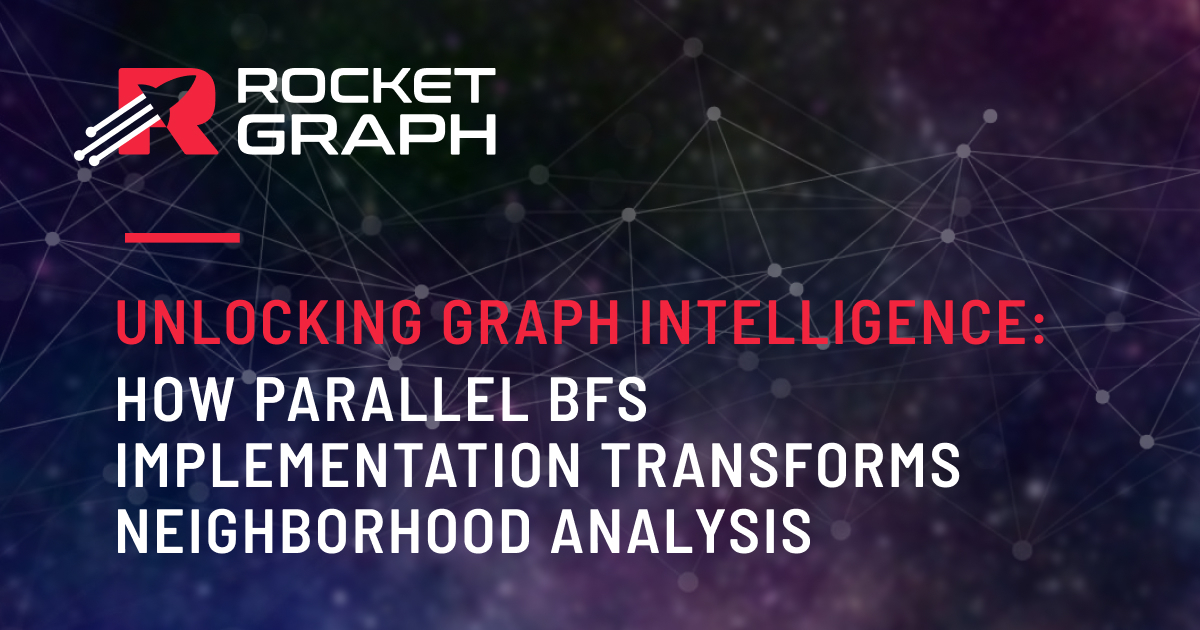From edge to Exabyte — Rocketgraph delivers what others can’t: zero-ETL, GenAI-driven graph analytics at planetary scale.
When it comes to traversing a graph, two algorithms dominate the landscape: Breadth-First Search (BFS) and Depth-First Search (DFS). Each has its strengths, and each solves a unique class of problems. While BFS has long been known for its potential in parallel computing, DFS has traditionally been considered inherently sequential — challenging to execute in parallel.
This limitation matters. Real-world issues such as cyberattacks unfolding over months, intricate financial fraud cycles, and complex supply chain dependencies require deep graph explorations, which BFS alone cannot adequately address. That’s the exact realm where DFS shines.
BFS vs. DFS: What’s the Difference?
| Aspect | Breadth-First Search (BFS) | Depth-First Search (DFS) |
| Traversal Strategy | Explores neighbors first, level by level | Explores as deep as possible before backtracking |
| Data Structure | Queue | Stack (or recursion) |
| Use Cases | Shortest path, reachability | Cycle detection, deep pattern detection |
| Parallelization | Highly parallelizable | Traditionally hard to parallelize |
| Typical Depth | Shallow to moderate | Deep, multi-step traversal |
Visualizing the Difference
The illustration below shows how these algorithms operate distinctly:

In Depth-First Search (DFS – left), we go deep before backtracking. In Breadth-First Search (BFS – right), we traverse level by level.
In BFS, nodes are traversed level by level, ensuring complete coverage of immediate neighbors before proceeding deeper. DFS, however, dives deeply down one path before backtracking, efficiently handling problems requiring depth and specificity.
The DFS Dilemma: Why It’s Been Hard to Scale
Unlike BFS, which easily distributes work across multiple processors due to its level-by-level exploration, DFS maintains a single path of exploration at any given time. This sequential nature creates challenges:
- State Management: Each DFS path is stateful, remembering its traversal history via a stack.
- Dependency Issues: Subsequent explorations depend directly on the outcomes of previous decisions, complicating parallel execution.
- Memory Management: Deep recursion can cause stack overflow issues, demanding careful memory optimization.
Historically, these complexities have made DFS inherently difficult to scale using traditional computing methods.
Rocketgraph’s Innovation: Parallel DFS Queries
Rocketgraph engineers approached this challenge innovatively, harnessing the principles of high-performance computing (HPC). Instead of parallelizing a single DFS traversal, Rocketgraph executes thousands of DFS queries simultaneously, each independently exploring different sections or patterns within the graph.
This method leverages Rocketgraph’s:
- In-Memory Graph Processing: Efficient memory usage allows real-time execution of multiple DFS traversals.
- Multi-threaded Architecture: Capable of parallelizing extensive graph-wide searches, dramatically reducing query latency.
- Graph-Wide Scanning: Ensures comprehensive coverage, eliminating blind spots typically encountered with indexed searches.
This revolutionary approach transforms DFS from a computational bottleneck into a scalable and efficient querying method, enabling analysts to execute deep, complex queries effortlessly.
Practical Use Case: Cybersecurity and Lateral Movement Detection
Consider a cybersecurity scenario where an attacker infiltrates an organization, hopping across multiple servers undetected over months—a classic example of lateral movement. Such attacks follow a DFS-like pattern:
- Initial Breach: Attacker compromises one server.
- Expansion: Gradually moves deeper into the network, escalating privileges and accessing sensitive systems.
- Exfiltration: Finally, steals data from critical endpoints.
Using Rocketgraph, security analysts can simultaneously deploy numerous DFS queries, rapidly uncovering these deeply nested attack paths. This capability significantly reduces detection and response times, offering proactive defense against sophisticated threats.
Extending the Impact: Other Applications
Beyond cybersecurity, Rocketgraph’s parallel DFS innovation delivers immense value in:
- Financial Fraud Detection: Identifying complex, multi-layered fraud schemes spanning various accounts and institutions.
- Supply Chain Analysis: Detecting vulnerabilities or bottlenecks deep within complex supply networks.
- Social Network Insights: Discovering hidden influencer networks and patterns of misinformation spread
From Impossible to Instant
Rocketgraph has fundamentally transformed DFS from being computationally impractical at scale to a powerful, instantaneously actionable analytics tool. With zero-ETL processes and intuitive natural language interactions via Mission Control, analysts across industries can leverage DFS’s depth and specificity without any coding.
From edge to Exabyte, Rocketgraph empowers enterprises to explore graph data deeper, faster, and smarter—revealing critical insights that traditional methods miss entirely.
Ready to see it in action? Start your free trial today and experience the power of parallel DFS with Rocketgraph.

